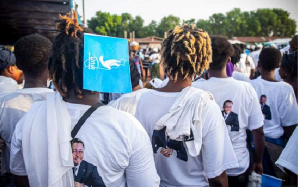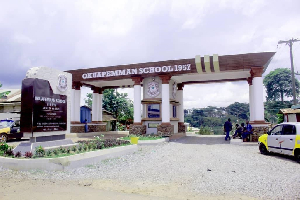- Home - News
- TWI News | TV
- Polls
- Year In Review
- News Archive
- Crime & Punishment
- Politics
- Regional
- Editorial
- Health
- Ghanaians Abroad
- Tabloid
- Africa
- Religion
- Election 2020
- Coronavirus
- News Videos | TV
- Photo Archives
- News Headlines
- Press Release
General News of Friday, 1 September 2006
Source: GNA
Sighted children dumped in blind schools as blind
Koforidua, Sept. 1, GNA- There are sufficient evidence to prove that many children in special schools for the blind in the country are not blind but suffering from low vision and could lead an independent life if given the required support.
Such children were therefore, taught to read the Braille with their eyes instead of their fingers because they have some level of vision and therefore could not perform well both in schools for the blind and also at normal schools without the necessary aid. The observation was disclosed by Mr James Anewenah, Country Representative of Sight Savers International(SSI), at the inauguration of a 219-million-cedi Low Vision Centre (LVC) at the Koforidua Regional Hospital(KRH) at Koforidua on Friday.
The KRH contributed 15 million cedis towards the rehabilitation of the building housing the Centre, while the SSI provided equipment costing 204 million cedis and in addition, donated two pick-up vehicles costing 510 million cedis.
Mr. Anewenah, who said the Centre was the first of a Secondary Level Low Vision in the country, explained that his organization was supporting the establishment of the Centre to help solve the needs of people suffering from low vision.
He said the Country Office of the SSI was also exploring the possibility of establishing a Primary Low Level Vision Centre at Hohoe in the Volta Region, while the West Africa Regional Office of SSI was also supporting the establishment of West Africa Low Vision Model Centre at the Korle-Bu Teaching Hospital to serve as a tertiary level centre. According to him, it was the strategic objective of SSI to establish a three-tier level low vision services in Ghana to serve as a model that could be emulated by other countries in the West Africa sub-region.
The National Co-ordinator of Low Vision Centres (LVC), Professor Christine Ntim-Amponsah, said the care of Low Vision (LV) patients went beyond the hospital to include the community support to enable them fit into the local social life.
The Eastern Regional Low Vison Co-ordinator, Mr Edmund Korda, explained that a low vision patient was not totally blind and also do not see normally and said the term could also be used for persons with significant reduction in their visual fields. He said the objective of Low Vision Service (LVS) was not restorative but to make such patients use their residual vision in a most effective manner to achieve an independent life style as much as possible.
An Eye Specialist of the KRH, Dr James Addy, explained that one of the major causes of LV was the traditional practices whereby when children suffer from convulsion, all sorts of preparations were put into their eyes, saying such concoctions tended to damage the eyes of the children and made them to suffer from LV. Dr. Addy mentioned some of the other causes of LV as corneal ulcer, corneal scar, measles, vitamin A deficiency and hereditary eye disorders and advised parents to stop their children from playing with pointed objects.
The Co-ordinator of the Integrated Education Programme for children with low vision in Akuapem North District, Mr Seth Kwasi Nyame, called on the Ghana Education Service to fully adopt the programme into the education system.
In a welcoming address, the Medical Director of the KRH, Dr Obeng Apori, appealed for additional optometrists and two ophthalmic technicians to help run the Centre.










